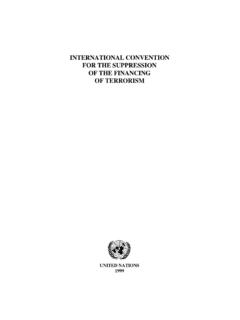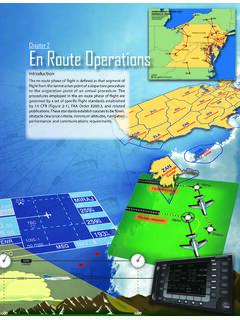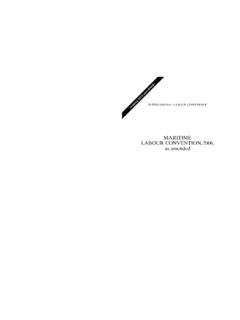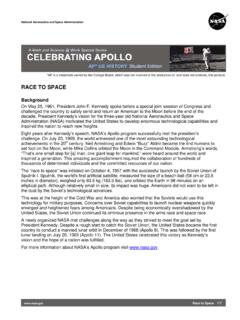Transcription of Psychological Bulletin
1 VOL. 51, No. 4 JULY, 1954 Psychological Bulletin THE CRITICAL INCIDENT TECHNIQUE JOHN C. FLANAGAN American Institute for Research and University of Pittsburgh During the past ten years the writer and various collaborators have been engaged in developing and utilizing a method that has been named the "critical incident technique." It is the purpose of this article to describe the development of this methodology, its fundamental principles, and its present status. In addition, the findings of a considerable number of studies making use of the critical incident technique will be briefly reviewed and certain possible further uses of the technique will be indicated. The critical incident technique consists of a set of procedures for collecting direct observations of human behavior in such a way as to facilitate their potential usefulness in solving practical problems and developing broad Psychological principles.
2 The critical incident technique outlines procedures for collecting observed incidents having special significance and meeting systematically defined criteria. By an incident is meant any observable human activity that is sufficiently complete in itself to permit inferences and predictions to be made about the person performing the act. To be critical, an incident must occur in a situation where the purpose or intent of the act seems fairly clear to the observer and where its consequences are sufficiently definite to leave little doubt concerning its effects. Certainly in its broad outlines and basic approach the critical incident technique has very little which is new about it. People have been making observations on other people for centuries. The work of many of the great writers of the past indicates that they were keen observers of their fellow men.
3 Some of these writers must have relied on detailed notes made from their observations. Others may have had unusual abilities to reconstruct memory images in vivid detail. Some may have even made a series of relatively systematic observations on many instances of a particular type of behavior. Perhaps what is most conspicuously needed to supplement these activities is a set of procedures for analyzing and synthesizing such observations into a number of relationships that can be tested by making additional observations under more carefully controlled conditions. BACKGROUND AND EARLY DEVELOPMENTS The roots of the present procedures can be traced back directly to the studies of Sir Francis Galton nearly 70 years ago, and to later developments such as time sampling studies of recreational activities, controlled observation tests, and anecdotal records.
4 The critical incident technique as such, however, can best be regarded as an outgrowth of studies in the Aviation Psychology Program of the United States Army Air Forces in World War II. The Aviation Psychology Program was established in the summer of 1941 to develop procedures for the selection and classification of aircrews. One of the first studies (40) carried out in this program was the analysis of the specific reasons for failure in learning to fly that were reported for 1,000 pilot candidates eliminated from flight training schools in the summer and early fall of 1941. The basic source used in this analysis was the proceedings of the elimination boards. In these proceedings the pilot instructors and check pilots reported their reasons for eliminating the particular pilot. It was found that many of the reasons given were clich s and stereotypes such as "lack of inherent flying ability" and ''inadequate sense of sustentation," or generalizations such as ''unsuitable temperament," "poor judgment," or "insufficient progress.
5 " However, along with these a number of specific observations of particular behaviors were reported. This study provided the basis for the research program on selecting pilots. Although it was found very useful, it also indicated very clearly the need for better procedures for obtaining a representative sample of factual incidents regarding pilot performance. A second study (13), which emphasized the importance of factual reports on performance made by competent observers, was carried out in the winter of 1943-1944 in the 8th, 9th, 12th, and 15th Air Forces. This study collected the reasons for the failures of bombing missions as reported in the Group Mission Reports. Although in the preparation of these reports much greater emphasis was given to determining the precise facts in the case, it was apparent that in many instances the official reports did not provide a complete record of all the important events.
6 Even with these limitations, the information given was found to be of considerable value, and the systematic tabulations that were prepared provided the basis for a series of recommendations that resulted in important changes in Air Force selection and training procedures. In the summer of 1944 a series of studies (74) was planned on the problem of combat leadership in the United States Army Air Forces. These represent the first large-scale, systematic effort to gather specific incidents of effective or ineffective behavior with respect to a designated activity. The instructions asked the combat veterans to report incidents observed by them that involved behavior which was especially helpful or inadequate in accomplishing the assigned mission. The statement finished with the request, "Describe the officer's action. What did he do?
7 " Several thousand incidents were collected in this way and analyzed to provide a relatively objective and factual definition of effective combat leadership. The resulting set of descriptive categories was called the "critical requirements" of combat leadership. Another study (74) conducted in the Aviation Psychology Program involved a survey of disorientation while Disorientation in this study was defined to include any experience denoting uncertainty as to one's spatial position in relation to the vertical. In this study pilots returning from combat were asked "to think of some occasion during combat flying in which you personally experienced feelings of acute disorientation or strong vertigo." They were then asked to describe what they "saw, heard, or felt that brought on the experience." This study led to a number of recommendations regarding changes in cockpit and instrument panel design and in training in order to overcome and prevent vertigo while flying .
8 In a project carried out in the Aviation Psychology Program in 1946, Fitts and Jones (12) collected descriptions of specific experiences from pilots in taking off, flying on instruments , landing, using controls, and using instruments . These interviews with pilots were electrically recorded. They provided many factual incidents that were used as a basis for planning research on the design of instruments and controls and the arrangement of these within the cockpit. In addition to the collection of specific incidents and the formulation of critical requirements, as outlined above, the summary volume (13) for the Aviation Psychology Program Research Reports contained a discussion of the theoretical basis of procedures for obtaining the critical requirements of a particular activity. Perhaps the best method of describing the status of these procedures at the close of the war is to quote from the discussion in this summary volume, which was written in the late spring of 1946.
9 In the section on techniques for defining job requirements, the present author wrote as follows: The principal objective of job analysis procedures should be the determination of critical requirements. These requirements include those which have been demonstrated to have made the difference between success and failure in carrying out an important part of the job assigned in a significant number of instances. Too often, statements regarding job requirements are merely lists of all the desirable traits of human beings. These are practically no help in selecting, classifying, or training individuals for specific jobs. To obtain valid information regarding the truly critical requirements for success in a specific assignment, procedures were developed in the Aviation Psychology Program for making systematic analyses of causes of good and poor performance.
10 Essentially, the procedure was to obtain first-hand reports, or reports from objective records, of satisfactory and unsatisfactory execution of the task assigned. The cooperating individual described a situation in which success or failure was determined by specific re-ported causes. This procedure was found very effective in obtaining information from individuals con-cerning their own errors, from subordinates concerning errors of their superiors, from su-pervisors with respect to their subordinates, and also from participants with respect to co-participants (13, pp. 273-274). DEVELOPMENTAL STUDIES AT THE AMERICAN INSTITUTE FOR RESEARCH 1 This study was planned by Paul M. Fitts, Jr., who also contributed to the previously mentioned USAAF studies and planned and carried out the interview study with pilots described below on the design of instruments , controls, and arrangements.














